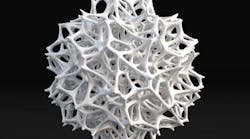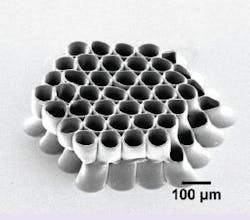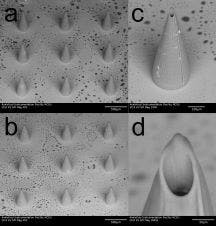When talk turns to 3D printing, the topic usually conjurs up images of plastic or metal parts you can hold in your hands. But it now looks as though 3D-printed parts with dimensions on the order of microns could soon begin having a particularly important impact on medical device technology.
So says Dr. Roger Narayan, a professor in the joint department of biomedical engineering at the University of North Carolina and N.C. State University. At the upcoming 2014 MD&M West Conference, Narayan will be speaking on 3D printing at small length scales for medical device applications.
Narayan says there are several approaches for fabricating small-scale parts like this, each with its own set of advantages and materials that are appropriate for use. The decision about which approach to take hinges on factors such as how quickly the parts must be made, the minimum feature sizes, whether the materials picked for initial prototyping are going to work all the way through commercialization.
Examples of super-tiny parts made with 3D printing techniques come from Narayan's lab in N.C. There, researchers have been devising 3D-printed devices for drug delivery, sensors, and scaffolds for tissue engineering through use of an approach that involves selectively hardening of polymers into features with dimensions on the order of microns. "3D printing has been successful at creating big items such as replacement hips and knees. Now we are seeing successes coming at the smaller-length scales," he says.
One technique Narayan's lab has been working on is two-photon polymerization (2PP), where a photosensitive material cures by means of nearly simultaneous absorption of ultrashort (e.g., femtosecond) laser pulses.
Narayan says the approach provides many possibilities for fabricating 3D microscale structures, including biomicroelectromechanical systems, microfluidic devices, biomedical implants, microneedles for transdermal drug delivery, and scaffolds for tissue engineering. He says the flexibility of 2PP in creating structures with well-controlled geometries and feature sizes ranging from below one micrometer to hundreds of micrometers makes this technique particularly appealing for fabrication of 3D tissue engineering scaffolds. In addition, patient-specific scaffolds for tissue engineering may be created using 2PP from patient imaging data.
One problem is in finding biocompatible photosensitive materials. A lot of photosensitive material is actually toxic to living cells. Researchers have tried several free-radical-generating molecules that are naturally found in biological systems. They say Riboflavin, also known as vitamin B2, has potential use as a biological photoinitiator.
Narayan says novel photoinitiators for biological applications must be developed to facilitate use of photopolymers in clinical medicine.
Though the riboflavin photoinitiator system exhibits excellent biocompatibility, it doesn't cure efficiently so far. With further improvement of the photoinitiator properties, the riboflavin–based photoinitiators play a role in realizing UV polymerization of completely biocompatible scaffolds or other medically relevant structures without extensive postprocessing.
Narayan's lab has also fabricated super-tiny microneedles with a rapid prototyping approach involving use of a digital micromirror device (DMD), which was originally developed by Texas Instruments. A tiny piece of carbon fiber gets inserted in the needles and the assembly is used to penetrate skin to deliver drugs.
As before, the microneedle fabrication used selective polymerization of a photosensitive acrylate-based polymer resin. Narayan says a variety of materials have been used for microneedle fabrication, including silicon, glass, stainless steel and nickel, and resorbable polymers such as polyglycolic acid and polylactic acid. Narayan's group used a commercially obtained acrylate-based polymer called e-Shell 200 for making needles. The material is a class-IIa biocompatible, water-resistant material that has been used in thin-walled hearing aid shells and other applications.
The group integrated carbon fiber electrodes within the bores of the hollow microneedles. The completed microneedle consisted of the microneedle array and a lower layer providing support for the carbon fibers and alignment of the carbon fibers to the microneedle array. The support component was fabricated from 1.6-mm-thick poly-methylmethacrylate . The group drilled an array of holes through it using a 60-W CO2 laser and a computer-controlled XY stage.
Narayan says the group used the digital micromirror device-based stereolithography instrument to make about 200 arrays in three hours. In studies where the carbon fibers poked through porcine skin, the microneedle arrays were able to penetrate the outermost layer of the skin and that the microneedles remained intact after insertion.



